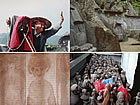|
Comments: |
Opening: 18 Sep 2003, 16:15pm
The 25000 Cultural
Transmission Center, Beijing, also known as The Long March Space, is
hosting Long March Space �The Power of the Public Realm, a
long-anticipated exhibition opening September 18th. One major aim of the
Long March project has been to re-appraise public space, to research and
document public resources and to study and exercise the connection between
display culture and artistic originality. The project also takes as its
aim an exploration of practice and theory, arts and text and audience and
works, all on the basis of the correlation between arts and life,
individuals and the collective society. The goals of The Long March
project are reflected in their criticism towards the ahistorical attitudes
that characterize contemporary art in China as represented by elite
culture.
The four artists featured in The Power of the Public Realm
are key participants in the Long March project, where folk visual culture
and elite artistic production come to terms. Master Li Tianbing, a
villager of western Fujian Province, a former revolutionary base, is a
Guinness record-holder and is famous for taking and developing photos
using only natural light. He took part in the first site of The Long
March, held in Ruijn, themed “Utopia and Chinese Context.�Jiang Jiwei,
the “Maxim Mountain Creator,�is known for his carvings of quotations and
images into a Quanzhou mountainside. His work was a major site at the
third stop of the Long March (Roads and Borders/Translation and
Transition). In Lijiang and Lugu Lake, the sixth site of the Long March,
the high-spirited works of retiree Guo Fengyi of Shanxi were featured as
part of a dialogue between Chinese feminist artists and Judy Chicago. Wang
Wenhai, a retired guide of the Yan’an Revolutionary Museum, is also a
participant of the current exhibition. He has created 1200 sculptures of
Chairman Mao over the last twenty years. Next year, he will be a highlight
the latter part of the Long March, though his collaboration with the Long
March began over a year ago.
The Long March faces multiple issues.
First are the pros and cons of directly exporting contemporary Chinese art
“from inside-out�to international exhibitions and markets. Second is the
way in which Chinese contemporary art superficially adopts practices of
the international art system without criticism. Western practices are
adopted though they may not be suitable for contemporary Chinese art and
may, in fact, be harmful. Third are the continuous discussions of
post-colonial theory without developing or adding anything new to the
theoretical debate. The fifth issue involves the tension and gap between
the idealism of the newly formed Dashanzi Art Zone and the surrounding
community. The Long March Space exists as a ground to balance these
issues. Its focus is to contextualize the lives of Chinese artists through
their works. Personal space, individualism and social environment are an
inseparable part of the lives of the four folk artists participating in
the current exhibition. They challenge our conception of what defines an
“artist.�BR>
The discourse generated by the historical Long March and
the visual representation of folk life following the revolution
demonstrated that elite art and folk art could co-exist and bond in an
interactive and dynamic way. The success of this time period proved to us
that the tension we are experiencing between art and society and the
anxiety of the Chinese art community towards the West in recent times is
not necessary when facing the conflict between the traditional and modern.
Hence, as we bring art to the public realm, we also bring “folk-art�and
“non-art�into our space. We hope that the public’s adoption of
contemporary artistic language and the representation of their life and
art from a contemporary perspective can create a dialogue focusing on
“what is art and what is contemporary.�BR>
25000 Cultural
Transmission Center
4 Jiuxianqiao Lu, Chaoyang District, Beijing,
China
(Mailing Address: Beijing PO Box No.554, P.R.China,
100015)
Tel/Fax: +86 (10) 64387107
Email: longmarch2003@vip.sina.com
Website:
http://www.longmarchfoundation.org/
Opening Hours:
daily, 11am - 7pm |
![]()
